

This cookie is set by GDPR Cookie Consent plugin. The cookie is used to store the user consent for the cookies in the category "Other. The cookies is used to store the user consent for the cookies in the category "Necessary". The cookie is set by GDPR cookie consent to record the user consent for the cookies in the category "Functional".


The cookie is used to store the user consent for the cookies in the category "Analytics". These cookies ensure basic functionalities and security features of the website, anonymously.
#BASS TUNING ONLINE FREE#
Once you're ready to play, try our free bass music such as Pachelbel's Canon or Vivaldi's Four Seasons in our FREE BASS SHEET MUSIC section, play Christmas carols in our FREE BASS CHRISTMAS MUSIC section, or play beautiful violin music by composers throughout history in our BASS STRING CLASS.Necessary cookies are absolutely essential for the website to function properly.

For violin, cello or viola tuning assistance, click here: Violin Tuning, Cello Tuning, Viola Tuning.
#BASS TUNING ONLINE PROFESSIONAL#
Some professional bassists use a “C extension” which extends the range of the lowest string’s pitch E1, down to the pitch C1.Consult your teacher to see if they have a different preference in using harmonics to tune (some bassists prefer using harmonics that divide the string in one-fourth or one-third). The resulting pitches will sound one octave above the open strings. To tune using natural harmonics, touch each string lightly at the middle point of your string that divides your string in half (halfway between the nut and the bridge), and pull your bow across each string. Some bassists find it helpful to use harmonics when they tune.If the pitch of the open string sounds higher than the correct pitch, gently turn the tuning key (machine peg) to the left. If the pitch of the open string sounds lower than the correct pitch, gently turn the tuning key (machine peg) to the right until it reaches the correct pitch. Although early basses used wooden pegs like other stringed instruments, most basses today use machine pegs with a geared tuning mechanism to adjust the strings (called tuning machines).Although the notated notes above are typically used to tune the bass, the actual pitch of the bass open strings will sound like the following notes: E1, A1, D2 and G2 The bass is a transposing instrument, meaning the note played sounds an octave below the notated pitch.More tuning assistance: Violin Tuning, Viola Tuning, Cello Tuning


 0 kommentar(er)
0 kommentar(er)
